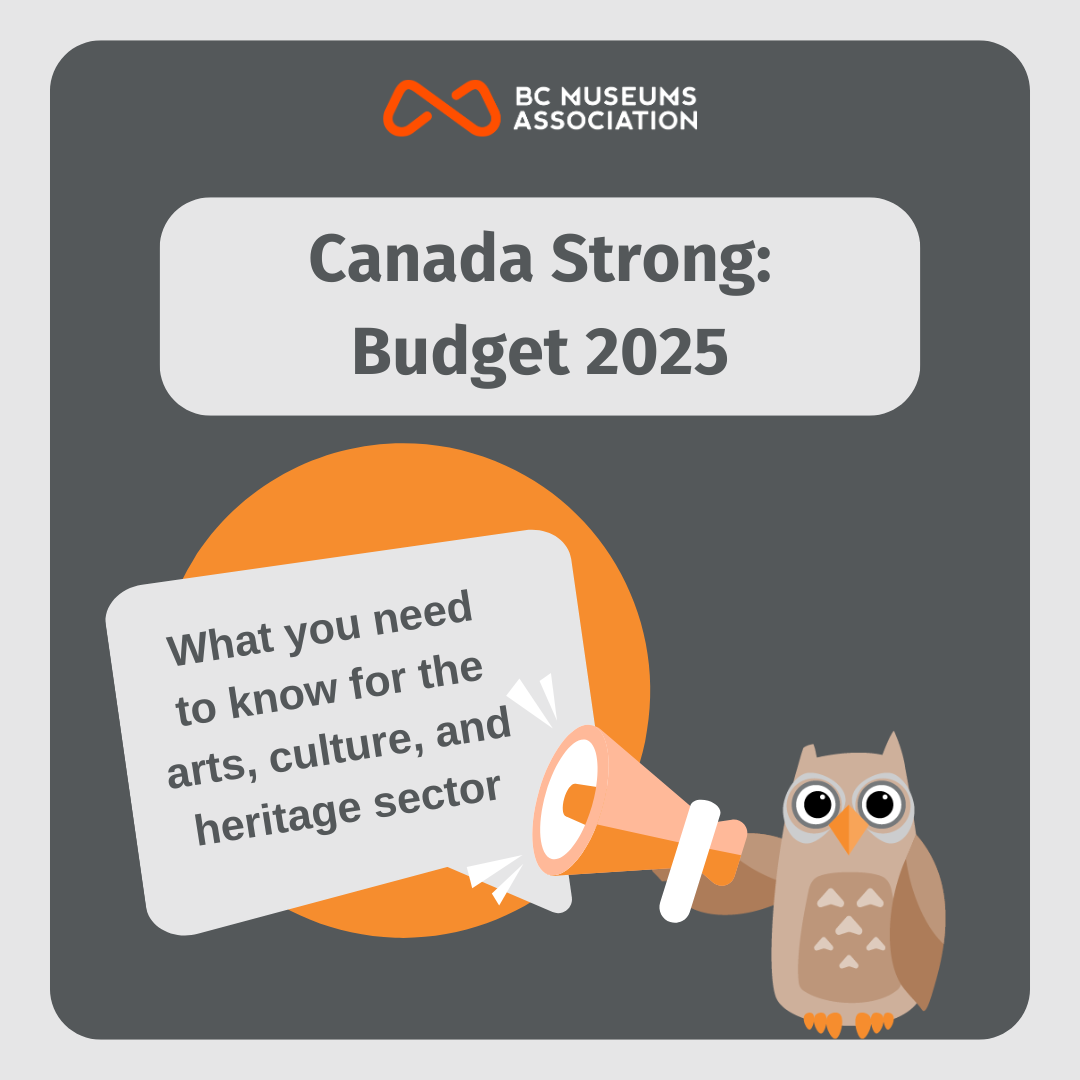Arts, Culture, and Heritage Takeaways from the 2025 Federal Budget
Considering the Canada Strong Budget

The federal budget passed on November 17th, 2025 and at the BCMA we have been reading the recent federal budget and resulting analysis. Policy forums, national arts and culture associations, and sector leaders have all been weighing in on the implications of the ambitions of the polarizing Budget 2025.
The thought leadership from our peers has us reflecting on our own pre-budget submission and the future for museums in this province and beyond. We are seeking input and feedback from our membership on this year’s budget at bcma@museum.bc.ca .
What is Budget 2025?
Budget 2025 was released with two key documents. The first is a 23-page overview of the federal government’s strategy called Our Plan: Building Canada Strong. The second, Budget 2025, is the 493-page budget with the explanations and number crunching.
While these documents speak to Canada’s unique identity and history and a drive to protect sovereignty, the federal government is clear that Budget 2025 is focused on defence, tariff response, tax cuts and building to support both housing and increase economic growth.
In addition, the federal government is also transitioning to a fall budgeting cycle to launch projects as soon as construction season starts. The BCMA will be supporting members to update their federal advocacy calendars through our Advocacy Calendar to match the changes in the federal budget cycle.
“More than 75% of our actions this year are to respond to significant global economic shifts” (Our Plan: Building Canada Strong, 2).
What’s new in Budget 2025?
The federal government has committed support for infrastructure projects that include Filipino Community and Cultural Centre in Metro Vancouver and the RCMP Heritage Centre in Regina (Budget 2025, 103).
A new Office of Digital Transformation with long-term plans to develop and guide the adoption of AI and new technology across government within the country, which will likely be hand-in-hand with the reduction of the public service staff (Budget 2025, 214).
Department of Canadian Heritage
There are changes at the Department of Canadian Heritage. The budget makes three- and four-year commitments towards festivals, celebrations, media and journalism, however, the department also must meet a 15% reduction over the next three years. With the federal government aiming to transform its internal processes, the Cultural Spaces Fund will be reduced and reoriented to “funding specialized equipment” as a “cost effective way to upgrade cultural facilities” (Budget 2025, 297).
Canada Council for the Arts
The Canada Council will receive $6 million over three years, starting in 2026-27 for the Arts to support professional artists and arts organizations.
Amendments to the Copyright Act to create an Artist’s Resale Right in Canada, ensuring visual artists benefit from future sales of their work. This means royalties from their work each time it is resold through an eligible sale, helping artists continue to make money off their work (Budget 2025, 172)
Canada Summer Jobs
Budget 2025 proposes to provide $594.7 million over two years, starting in 2026-27, to Employment and Social Development Canada for Canada Summer Jobs to support around 100,000 summer jobs in summer 2026 (166).
Parks Canada
Parks Canada is also mandated to meet up to 15% in savings over the next three years. Parks Canada will be asked to reduce their library services and reduce participation and presence in off-site community events and festivals (Budget 2025, 296).
Canada Strong Pass
As announced on October 10, Budget 2025 proposes to provide $116.3 million over two years, starting in 2025-26, to renew the Canada Strong Pass for the holiday season, from December 12, 2025 to January 15, 2026. Canada Strong will also be available again for summer 2026.
In reviewing the Canada Strong Pass from Summer 2025, the federal government confirms visitors to museums were up 15% on average (Budget 2025, 173). These numbers are likely only from those included in the pass program, and the only B.C museums to participate in summer 2025 was the Royal BC Museum.
“We will unite in solidarity around our own unique identity, history, and geography by protecting our culture, nature, official languages, and core values. We will build in true partnership with Indigenous Peoples” (Our Plan: Building Canada Strong, 8).
What is not in this budget?
The budget does not expand the Canada Strong pass access to non-profit-run museums, nor does it clarify struggles to communicate to visitors the importance of paying admission for non-federally run sites. There is no recognition of the tensions the Canada Strong pass created for non-profit museums that had to explain to tourists why they were not part of Canada Strong.
Sadly, there is no mention of the long-overdue National Museum Policy. We invite you to review our position paper co-published with the First Peoples’ Cultural Council on the need for a National Museum Policy and our advocacy updates on the topic from previous years.
There is no direct funding line for the repatriation of belongings, leaving a gap in addressing Indigenous Cultural Heritage Rights. While there are earmarks for Indigenous tourism and proactive partnerships with Indigenous Peoples through the Canada Infrastructure Bank’s Indigenous Equity Initiative and the Indigenous Loan Guarantee Program, The Assembly of First Nations stated a striking concern; “That this budget has significant gaps in social areas, including no specific First Nations investments in health, training, language, or Truth and Reconciliation.”
What is the cultural sector saying about this budget?
There are calls within the broader arts and culture sphere that certainly celebrate the commitment to the Canada Council for the Arts from organizations like Canadian Coalition for the Arts, Business Arts & The BC Alliance for Arts and Culture. Many of these organizations focus their applause on the recent commitments to the Canada Council for the Arts, where funding cuts may have been expected.
In the museum sector, the Canadian Museums Association (CMA) and the Museums Association of Saskatchewan offer a more critical lens that this budget will not fill the crucial need for stable, multi-year funding and urges this budget to be reconsidered. The CMA’s position reflects a pervasive concern across the cultural domain regarding the precarity of short-term funding cycles and the necessity of capital investment to meet contemporary institutional demands.
There are also those in the cultural sector that hear both signals, such as Menon Dwarka views the Canada Strong budget as a recognition from the federal government that arts and culture as a vital component of the national economy and social fabric but also remarks there is a signal for more strategic, rather than purely compensatory, government support.
In more broad public policy realms, The BC Policy Solutions remarks “The prime minister stressed the need for Canadians to “sacrifice” in a time of crisis, but the budget betrays some striking choices about who is asked to sacrifice and who isn’t”. The Public Policy Forum (PPF) emphasizes that Budget 2025 budget’s success will be measured not just by immediate fiscal adjustments but by its capacity to enhance Canada’s overall productivity and address systemic societal issues.
One of the closing lines in the Our Plan section of Budget 2025 is to ‘We will build in true partnership with Indigenous Peoples’. This budget includes no specific Indigenous peoples chapter and CTV reports there are concerns this will create barriers in Indigenous communities. Aligned with the aforementioned Assembly of First Nations concern that this budget has gaps in reconciliation, Riley Yesno’s brief at the Yellowhead Institute states “generational funding gaps will be further compounded, existing progress potentially reversed, and Indigenous communities left with even more work to do.”
The Carney Government has titled this budget Canada Strong, conjuring the feelings of protecting Canada’s Cultural Sovereignty. While there is some recognition of power the cultural sector plays in that strength, the strongest signal in this budget is that the nation building priorities are in building up industries to compete globally.
What strikes us in this budget?
What we see is that this year’s budget is that the federal government does see large museums as instruments in their Canada Strong ambition, yet much like the 2025 roll out of the Canada Strong pass, the remainder of the museum and cultural sector lacks the visibility, integration, and funding commitment of the federal government.
Take the next steps.
Jules André Brown, Executive Director of the BCMA, will be joining the Canadian Museum Association, and our Provincial and Territorial colleagues in Ottawa for a day on Parliament Hill in early December. The delegation are going to talk to MP’s, policy leaders, and staff about the importance of museums like you. Topics to be discussed include the National Museum Legislation, clearer support for repatriation, and the value of the Young Canada Works program.
Please feel free to send us your thoughts, testimonies, and guidance for our journey to Ottawa. Please reach out to us at bcma@museumsassn.bc.ca before December 1.

